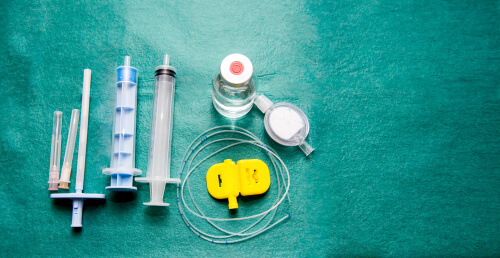The Walking Epidural and Its Influence on Delivery

Using an intermediate anesthesia for delivery has been studied and investigated numerous times. One of the great achievements in this regard is the “walking epidural.”
The main advantage of the walking epidural is that pain is reduced without paralyzing the mother. This way, she can collaborate in the childbirth process with greater ease.
This anesthetic is also known as the ambulatory epidural. The mother-to-be can move, but abdominal pain is inhibited.
The body doesn’t fall asleep, as with other types of anesthesia. This can be very useful in the first three hours of labor.
Doctors say that a walking epidural is as safe as the more popularly known epidural. The great advantage is that the mother can adopt the most comfortable position to push from.
It’s also very positive psychologically, since the woman feels involved and has autonomy in this unforgettable moment.
Application technique
The procedure is carried out similarly to the traditional epidural. The difference is the medication and the administered dose.
The patient sits and forms a “C” with her back, and the injection is applied between the vertebrae. A needle places the catheter that the anesthetic will pass through.

Advantages of a walking epidural during childbirth
- The ability to move. Once applied, the woman doesn’t lose feeling in her lower limbs. Moving without feeling the pain of contractions helps dilation occur more quickly.
- Greater comfort. By having control of her lower areas, the mother can position herself as she wishes. This way, she participates in the delivery in a way that makes her feel more secure.
- Greater ease in pushing. One of the hardest and most beautiful phases is finding the strength to help the baby out. It has been proven that a walking epidural makes this moment easier for the mother.
- It takes effect quickly. Once placed, the walking epidural has a faster effect than the traditional one.
- Less urine retention. The fact that the muscles are less inhibited means it’s easier to urinate.
- Application in different phases. This anesthesia can be applied at any time during delivery. It will be a special doctor or nurse who decides when to use it, in combination with the mother.
Disadvantages of a walking epidural
- The catheter cannot be repositioned.
- It causes more nausea than a traditional epidural.
- Some people believe there may be a small tremor in the legs that causes an unwanted hit.
- The opioids that are administered cause the skin to itch.
- Headaches.
Although it seems miraculous, the truth is this type of anesthesia cannot always be given. As with everything related to health, your doctor must evaluate you to determine which anesthetic is appropriate.
In addition, when the delivery is already at an advanced stage, a walking epidural isn’t recommended. In those cases it’s preferable to use the traditional one.

Do all medical centers have it?
Some hospitals don’t have this type of anesthesia yet, typically because a special protocol is required. The medical centers need more personnel and resources for deliveries with walking epidurals.
After the anesthesia is applied and takes effect, the patient must be evaluated to be sure she has full control of her legs. This is done via specific techniques and cannot be done everywhere.
It’s always necessary for the mother to be accompanied by another adult whom she trusts. Beyond the psychological support so necessary for that day, this person will be of great help during the process.
An unanticipated effect of the anesthesia can cause discomfort or an accident. The security of having someone next to you can be fundamental.
As in all deliveries, fetal control is vital. While all the circumstances are supervised, risks can be inhibited and the doctors will always be the ones to determine what is best for mother and child.
Being informed and prepared is a commitment that parents must rise to. Their participation in everything that surrounds the birth must be an act of love and responsibility.
Using an intermediate anesthesia for delivery has been studied and investigated numerous times. One of the great achievements in this regard is the “walking epidural.”
The main advantage of the walking epidural is that pain is reduced without paralyzing the mother. This way, she can collaborate in the childbirth process with greater ease.
This anesthetic is also known as the ambulatory epidural. The mother-to-be can move, but abdominal pain is inhibited.
The body doesn’t fall asleep, as with other types of anesthesia. This can be very useful in the first three hours of labor.
Doctors say that a walking epidural is as safe as the more popularly known epidural. The great advantage is that the mother can adopt the most comfortable position to push from.
It’s also very positive psychologically, since the woman feels involved and has autonomy in this unforgettable moment.
Application technique
The procedure is carried out similarly to the traditional epidural. The difference is the medication and the administered dose.
The patient sits and forms a “C” with her back, and the injection is applied between the vertebrae. A needle places the catheter that the anesthetic will pass through.

Advantages of a walking epidural during childbirth
- The ability to move. Once applied, the woman doesn’t lose feeling in her lower limbs. Moving without feeling the pain of contractions helps dilation occur more quickly.
- Greater comfort. By having control of her lower areas, the mother can position herself as she wishes. This way, she participates in the delivery in a way that makes her feel more secure.
- Greater ease in pushing. One of the hardest and most beautiful phases is finding the strength to help the baby out. It has been proven that a walking epidural makes this moment easier for the mother.
- It takes effect quickly. Once placed, the walking epidural has a faster effect than the traditional one.
- Less urine retention. The fact that the muscles are less inhibited means it’s easier to urinate.
- Application in different phases. This anesthesia can be applied at any time during delivery. It will be a special doctor or nurse who decides when to use it, in combination with the mother.
Disadvantages of a walking epidural
- The catheter cannot be repositioned.
- It causes more nausea than a traditional epidural.
- Some people believe there may be a small tremor in the legs that causes an unwanted hit.
- The opioids that are administered cause the skin to itch.
- Headaches.
Although it seems miraculous, the truth is this type of anesthesia cannot always be given. As with everything related to health, your doctor must evaluate you to determine which anesthetic is appropriate.
In addition, when the delivery is already at an advanced stage, a walking epidural isn’t recommended. In those cases it’s preferable to use the traditional one.

Do all medical centers have it?
Some hospitals don’t have this type of anesthesia yet, typically because a special protocol is required. The medical centers need more personnel and resources for deliveries with walking epidurals.
After the anesthesia is applied and takes effect, the patient must be evaluated to be sure she has full control of her legs. This is done via specific techniques and cannot be done everywhere.
It’s always necessary for the mother to be accompanied by another adult whom she trusts. Beyond the psychological support so necessary for that day, this person will be of great help during the process.
An unanticipated effect of the anesthesia can cause discomfort or an accident. The security of having someone next to you can be fundamental.
As in all deliveries, fetal control is vital. While all the circumstances are supervised, risks can be inhibited and the doctors will always be the ones to determine what is best for mother and child.
Being informed and prepared is a commitment that parents must rise to. Their participation in everything that surrounds the birth must be an act of love and responsibility.
This text is provided for informational purposes only and does not replace consultation with a professional. If in doubt, consult your specialist.








